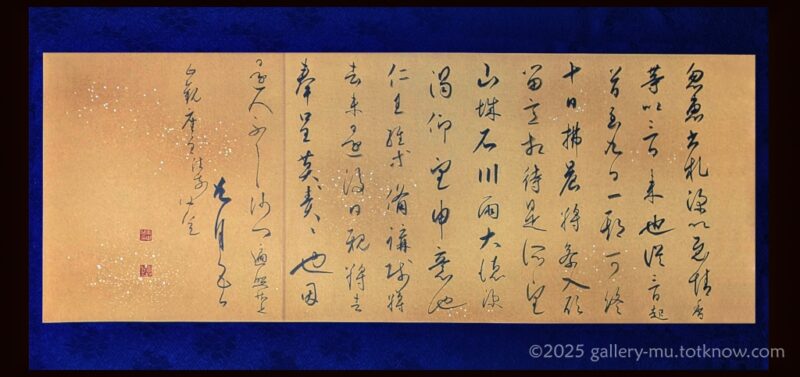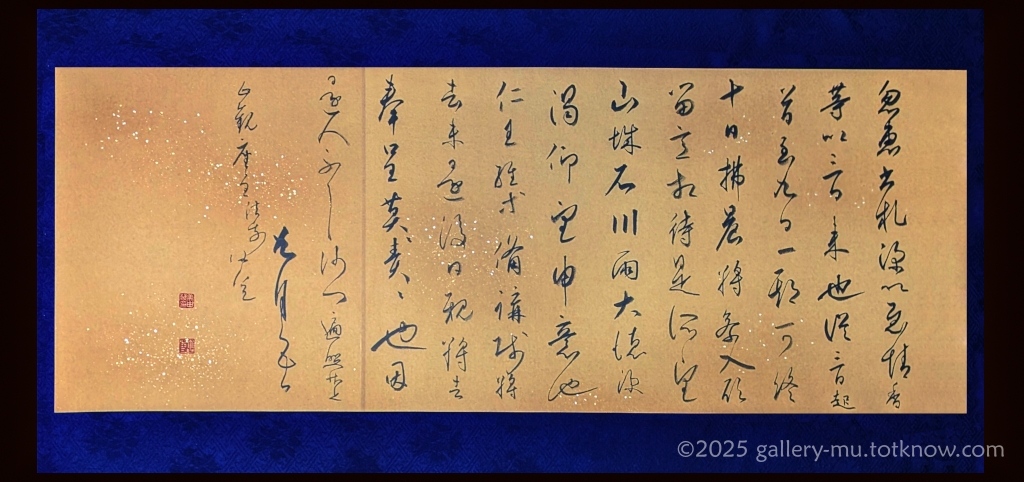#239 Full transcription of Kokkeijō

| Size: | approx. 34 × 66 cm |
|---|---|
| Dressing: | framed |
What kind of classic is this?
The Fūshinjō is a renowned scroll that brings together three letters sent by Kūkai (also known as Kōbō-Daishi) to Saichō (Dengyō-Daishi) in the early Heian period. The third letter is the Kokkeijō, which is the piece I have transcribed in full.
Kūkai is counted among the “Three Brushes” and is one of the foremost masters of Japanese calligraphy. After studying esoteric Buddhism as a Japanese envoy to Tang China, upon his return he absorbed Chinese calligraphic methods, leaving a profound influence on his contemporaries and later generations. The flowing semi-cursive style and brushwork seen in Fūshinjō are often noted to reflect the influence of the Chinese master Wang Xizhi.
The Kokkeijō is thought to have been written around the Kōnin era (811-813) based on its content, and was exchanged in the course of correspondence with Saichō. The text suggests matters of borrowing and granting Buddhist scriptures, giving a glimpse of the scholarly and religious exchange of the age.
Among its calligraphic features are long strokes made in one breath and skilful handling of ink-continuations, twists, and faintings. This technical mastery strongly points to the expert use of brush and paper and the motion of a continuous line, making its detailed aspects (brush route, tip control, ink density) particularly rich for study through transcription.
A fresh experience of transcription
Until now, I had often practised transcription on hanshi-sized papers with six characters at a time, but trying a full-scale reproduction entirely changed my perspective. First, I had to reconsider the selection of brush, paper and ink — issues that never arose in my small-scale practice. I referenced several facsimiles of the original, each with different magnification ratios, and moved back and forth between the details of the original text and its overall rhythm.
I also experimented with various writing methods: standing, lifting the brush or slightly floating the paper, and so on — through which I experienced the changes in line-extension and brush-pressure. In doing so repeatedly, there came moments when I could see why Kūkai had chosen a particular form, thickness or ink moisten–dry contrast — and those moments were the great pleasure of transcription.
What I realised while writing is this: Kūkai did not write in order to imitate someone else. Because of that, no matter how faithfully one copies, one can never reproduce the original exactly. Rather, I felt that the awareness born of that difference contains one’s own discovery. In the final stage I also tried writing without looking at the original simply relying on the brush-memory and flow of strokes — it felt like a conversation with Kūkai from 1,200 years ago, and to me that is the true essence of transcription.
Exhibition Announcement
The work shown in the opening photograph has been produced for an exhibition. I chose a decorative mounting — a paper sprinkled with gold and silver particles — to give it a somewhat more festive look. Of course, Kūkai did not use such luxurious paper in his letters; this was my choice for the sake of display.
The background fabric is finely-woven silk dyed deep indigo.
This framed piece will be exhibited as a master’s work at the 8th Iroha Kai Exhibition. I invite you to view it in person when you are nearby.
Dates: November 8 (Sat) 9:00-17:00, November 9 (Sun) 9:00-16:00 (Reiwa 7)
Venue: Saitama Prefectural Saitama Kaikan, Exhibition Rooms 1 & 2
3-1-4 Takasago, Urawa-ku, Saitama-shi, Saitama Prefecture
Access: JR Urawa Station (West Exit) ≈ 6-minute walk

